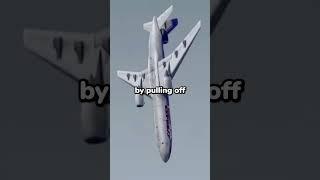
The Pilots Who Defeated A Hijacker: FedEx Flight 705 | #aviation #fedex #airplane
Комментарии:

I dont think that this is a coincidence. I scrolled past this cid and the exact same crash was shown and told in the vid like wtf
Ответить
50 40 30 20 10 butter 🧈
Ответить
GTA be like
Ответить
Damm thanks God everyone's okay
BTW was atc like
THE H*** THE PLANES DOING RANDOM MANUVERS AND THE RADIOS LIKE
AAAAJSJISJDJSNDISMDISJO.........

MD-10?💀
Ответить
i signed the pention
Ответить
Bro said not today 💀
Ответить
Fun fact: this was known as the “most dangerous manuver on a dc-10”
Ответить
Bro aint delaying the packages💀
Ответить
Flight 375 Hijacking: WHAT ABOUT ME
Ответить
The FedEx one was was like kind of ok enough but I would say VASP 375 is way better in emergency landing
Ответить
I’m honestly surprised this has been made into a movie yet
Ответить
The fact that the plane didnt stall is insane
Ответить
They should brought bodyguard
Ответить
FedEx 705 vs vasp 375😮
Ответить
It’s the federal express flight 705
Ответить
Vasp flight 375 what am I a roach? I save many people from my hijacking
Ответить
He was a Black man Under gun or bet
Ответить
Is the pilot okay now?
Ответить
vasp 375:
Ответить
k a c h i n g🤑🤑🤑
Ответить
VASP 375:I can relate I got put at gunpoint to go to Brazilia ((we went to Rio to piss him off))
Ответить
That hijacker are so f****d up.... he wants to earn easy money, by killing everyone, including himself in the plane crash! Is he insane?!
Ответить
A black man
Ответить
I like when the alarm said go up go up
Ответить
Fed ex crew are build diffrent
Ответить
What about VASP 375?
Ответить
Same for VASP 375
Ответить
Vasp flight 375
Ответить
F
Ответить
Fed ex flight 705 vs Fed ex flight 80 vs Fed ex flight 14
Ответить
Fedex + Vasp
Was hijacked and im not kidding

did the engineer ( hijacker ) died?
Ответить
Ok,but why a FedEx
Ответить
"the crew fought back" gave me the child
Ответить
The plane reached mach 1
Ответить
It's FedEx flight 80😂
Ответить
Still VASP 375 is the best hijacked landing plane
Ответить
I remember fedex flight 18
Ответить
Do VASP 375
Ответить
Save the plane 🇬🇧🇺🇸 married
Ответить
You forgot vasp 375
Ответить
why would he kill his self for 5 m dollars😢😢😢
Ответить
What do learn
Me: do not messing with fedEX

With the cockpit filled with blood dang
Ответить
Planes fly at high altitudes for several important reasons, each of which contributes to the efficiency, safety, and comfort of air travel. Here’s a more detailed breakdown:
### 1. Fuel Efficiency
One of the primary reasons commercial airplanes fly at high altitudes (typically between 30,000 and 40,000 feet) is to maximize fuel efficiency. At higher altitudes, the air is thinner, meaning there is less air resistance, or drag, on the aircraft. This reduction in drag allows the airplane to fly more smoothly and at higher speeds, all while using less fuel. Fuel is one of the largest operating costs for airlines, and reducing drag leads to a more economical flight. Aircraft engines are also designed to operate more efficiently in this thinner atmosphere, further contributing to fuel savings.
### 2. Smoother Flight and Less Turbulence
At lower altitudes, airplanes encounter more turbulent air because they are flying through the denser layers of the atmosphere. The lower part of the atmosphere (the troposphere) is where weather systems and air currents are most active, causing turbulence from storms, wind shear, and other factors. By flying at higher altitudes, planes are able to avoid much of this turbulence, as the air is calmer and more stable. This results in a smoother and more comfortable ride for passengers, as well as less strain on the aircraft.
### 3. Safety and Response Time
Flying at high altitudes gives pilots more time to react in the event of an emergency. Higher altitudes provide a greater margin of safety, offering pilots more time to troubleshoot issues or perform emergency maneuvers if needed. In the event of an engine failure or other serious problem, pilots have more time to glide the aircraft and find a safe place to land. Additionally, flying at higher altitudes places the aircraft well above most natural obstacles, such as mountains, and reduces the risk of collisions with other aircraft, since commercial air traffic is organized into different altitude levels to maintain safe separation.
### 4. Optimized Engine Performance
Jet engines are designed to work more efficiently in the thin air of higher altitudes. At cruising altitude, the engines can operate at their optimal power settings, where they consume less fuel while producing more thrust. The cooler air at these higher levels also helps with engine cooling, which improves performance and reliability. Moreover, since the air is less dense, the engines don’t have to work as hard to generate the same amount of thrust, further contributing to fuel efficiency.
### 5. Air Traffic Control and Separation
As air traffic grows, efficient airspace management becomes crucial. Air traffic controllers direct flights in designated "altitude bands" to keep them separated, especially in busy air corridors. By flying at high altitudes, commercial aircraft are able to maintain safe distances from other planes. Aircraft are typically assigned cruising altitudes depending on their direction of travel—flights traveling eastward might be assigned even altitudes (e.g., 35,000 feet), while flights traveling westward might fly at odd altitudes (e.g., 33,000 feet). This system helps prevent midair collisions and keeps the skies organized.
### 6. Weather and Wind Patterns
The weather patterns at higher altitudes are typically more predictable and stable compared to the turbulent lower levels of the atmosphere. The jet stream, a fast-moving air current that flows from west to east at high altitudes, can be harnessed by aircraft flying in the same direction. By flying within or along the jet stream, planes can take advantage of these strong winds to save fuel and shorten flight times. Pilots can also avoid dangerous weather systems, such as thunderstorms and large storm fronts, by flying above them.
### 7. Extended Range and Efficiency
Higher altitudes allow for more efficient cruising, extending the aircraft’s range. For long-haul flights, this means that planes can fly more efficiently over great distances without needing to stop and refuel. The ability to fly at high altitudes also allows airlines to make optimal use of their aircraft, offering the potential for longer routes or reduced fuel consumption on existing routes.
### 8. Environmental Considerations
Flying at high altitudes can also have environmental benefits. Reduced fuel consumption means fewer emissions, which helps airlines meet environmental goals and reduce their carbon footprint. While aviation still contributes to greenhouse gas emissions, flying at high altitudes improves fuel efficiency and can help mitigate the environmental impact of each flight.
### 9. Passenger Experience
Although not a primary consideration for the operation of the plane, flying at high altitudes contributes to a more pleasant passenger experience. For one, the lower atmospheric pressure at higher altitudes results in less air resistance, leading to quieter flight conditions. In addition, the smoothness of high-altitude flight reduces discomfort from turbulence. Some passengers may also find that the views from 30,000 feet or more are spectacular, offering a unique perspective on the Earth below.
### Conclusion
In sum, airplanes fly at high altitudes because it allows them to maximize fuel efficiency, avoid turbulence, ensure safe air traffic separation, optimize engine performance, and take advantage of favorable wind and weather patterns. All of these factors contribute to safer, more economical, and comfortable flights.

Support FedEx
Ответить
Blud really wanted that promotion and not get the packages late! W crew👏👏👏
Ответить
BRO THE PLANE IS LIKE 29 YEARS OLD, OFC THEY SCRAP IT
Ответить

























